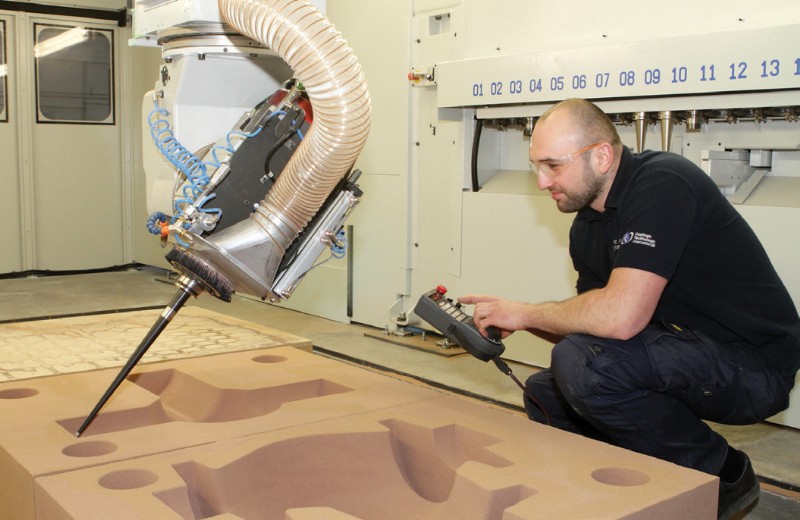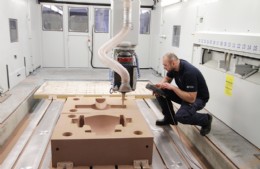Meeting the Economic Challenges


The patterns are expensive to produce and maintain they occupy valuable storage space for the lifetime of the finished design, where they are susceptible to damage. Modifying them in response to changing requirements, new castings technologies and opportunities to improve the efficiency of the design is equally expensive, but they are a lower cost, more versatile alternatives to the conventional route.
Alternative technologies also offer economies that go beyond eliminating the cost of pattern making by enabling foundries to produce near net shape castings with a superior surface finish and improved dimensional accuracy, requiring little or no ‘detailing’ far less finish machining, as well as lower, to zero, non-conformance costs. The same technologies allow new designs to be produced in half the time it would take using a conventional wooden pattern. They also allow casting designs to be modified just as easily and open the way for manufacturers to reverse engineer products, using a Coordinate Measuring Machine to collect the data needed to produce the CAD design which is at the start of the process.
Alternative technologies include Patternless and Quickcast processes such as Replicast®, MEGAshell® and Repliwax®.
Replicast® is a novel moulding and casting process, developed by Cti, which can be used to make high integrity castings, with improved machinability and an excellent surface finish, weighing from a few grams, up to 3.5 tonnes. Replicast® replaces expensive wooden patterns with dimensionally precise replicas made from expanded polystyrene and solid polymer. CAD design data from is fed to a CNC machine which cuts the replica out of a solid block of polystyrene or builds it up from polymer in an SLA 3D printer.
More complex shapes are made by gluing different polystyrene and polymer parts together and, once the replica is complete, it is dipped in a tank full of a special slurry to create a ceramic shell. The shell is significantly thinner than a traditional investment casting shell but with the same excellent internal surface finish.
Shells are fired, removing the foam and polymer, put in casting boxes and surrounded with refractory sand. The boxes are shaken on a vibrating table before air is drawn out of the sand to create a firm support for the shell, after which molten metal is poured in. Heavier shells, which don’t require supporting sand can be used for producing castings from reactive metals which have to be poured in a vacuum.
Using inert ceramic shells reduces the possibility of hydrogen defects, which can be a problem with certain Nickel based alloys. Replicast® techniques lie at the heart of the MEGAshell® process, which enables larger polystyrene replicas and ceramic shells with dimensions of up to 2m3 to be produced, allowing heavy section valve castings, weighing several tonnes to be manufactured, which are 34 per cent lighter than the sand cast equivalent.
Machining cost reductions of 50 per cent or more can be achieved and the process has been regularly used to make large, near net shape castings in costly alloys of steel and nickel. Cti has also refined the technology so that it can also be used for reactive alloys of titanium and zirconium. Demand to extend the weight range of near net shape investment castings, while reducing manufacturing costs has led Cti to develop its Repliwax® process for higher volume production.
In this process, liquid wax is injected into an aluminium or steel die and allowed to solidify to create the sacrificial pattern, which is then coated with ceramic. It is also possible to produces moulds and cores from sand without patterns, by 3D printing. This technology enables complex cores that would normally require multiple core-boxes, to be made in one piece, through a process of printing layers. Because there are no restrictions on undercuts, cores that would otherwise be impossible to make by traditional techniques can also be produced. Regardless of size, moulds and cores can be made with an accuracy of ± 0.25mm, enabling sand castings to be made to dimensional standards equivalent to that of lost wax investment castings (ISO 8062 Casting Tolerance Grade CT4 to CT6).
Tel: +44(0)114 254 1141
Email: info@castingstechnology.com
Web: www.castingstechnology.com
Published: 3rd February 2017
Rachel Wormald, Managing Director at YPS Valves Ltd and Elizabeth Waterman, ...
Are you looking for industry-leading, brand independent valve and actuator ...
As can be seen from the photograph, clearly the resident birds at Bartlett ...
Howco Group has unveiled its latest £1million investment, with the ...
In 2024, Allvalves is poised for an exciting year of growth and expansion, ...
GMM Pfaudler Engineered Plastics & Gaskets are delighted to bring the ...
In the ever-evolving valve industry, GMM Pfaudler stands out for its ...
SAMSON Controls Ltd – part of the SAMSON group - a renowned leader in ...










